
498 views

Pattadakal: The Ceremonial Capital of the Chalukyas
By Rahuldev Rajguru
Last Updated: 10 Mar 2023
We didn't know that serendipity awaited us. That, over the parched earth, slowly and gradually like the emergence of distant hills over hidden valleys, a majestic wonder would arise right before our eyes. We were still in travel heaven, soaking in mild temperatures of below 30 degrees celsius. The cool winter breeze told us that it was the right time to be in Northern Karnataka. We had been driving for over an hour through long, brooding, silent roads in interior Karnataka. We were anticipating the magic of Badami, the first planned stop in our week-long family winter vacation. But fate is mysterious, it calls out to you even when you’re not listening. So, it happened that day, with a gregarious sun and never-ending roads, that we reached a historical marvel.
It happened this way, Google Maps on my phone alerted me to the fact that there was a 10-minute traffic congestion down the road, and suggested an alternate route. After deviating from the highway, we entered a small quaint village. On the left side of the road, palm trees dotted a perfectly manicured park. The park did not seem to end even after driving for 300 meters, until out of nowhere, amidst the canopies, domes of exquisitely carved temples emerged, like heaven just dropped down for us. Our jaws dropped, our hearts stopped. It was the most beautiful moment in our lives. We were at Pattadakal, a UNESCO World Heritage Site, considered as an "illustration of eclectic art at its height." Its individuality is so striking that UNESCO has described it as a "harmonious blend of architectural forms from Northern and Southern India."
While we had heard about this place, we were unaware of its grandeur. Pattadakal, usually not on the tourism radar of Karnataka, was now flooded with hundreds of students. A torrent of school buses had clogged an already narrow highway, so Google suggested we divert through the town. We had Pattadakal on our list of places to see after visiting Aihole. Now, we knew what we were going to discover. It was with great excitement that we checked into Badami Heritage Resorts, one of the few nice properties in the area, and awaited our temple visits to begin on the next day.

Chalukya Temples in Pattadakal with Nagara (North Indian) style architecture
Pattadakal : The coronation site with the red soil
Pattadakal lies on the banks of River Malaprabha (a tributary of River Krishna). The majority of rivers in India flow north to south. But river Malaprabha is rare, as it flows in the opposite direction. It changes direction just before it reaches Pattadakal, flowing majestically from south to north and that's why it is called Uttaravahini. Inevitably carving a legacy in South Indian history, the Malaprabha River cuts through the valley of mountains. The river's pathway follows the coronation site of Yuvrajs (sons of the kings) of Badami Chalukya, gently nudging the rocks they were crowned on during its trajectory. In Kannada, this process of coronation is called Pattabhishek. The traditional crown in Karnataka is made from patta (cloth), "patta" is synonymous with crown. "Kal'' means rock in Kannada. The city earned its name Pattadakal from this historical legacy. Pattadakal befittingly translates to "coronation stone". Interesting, isn't it?

Various sculpture remains that were found during the excavation
The Chalukyas built their first temples in Aihole during the 5th and 6th century, and then in Badami Caves during the 6th and 7th century. It was in the 7th and 8th century that they began building Hindu temples at Pattadakal. The predominant presence of red soil in Pattadakal, earned itself another name, Raktapura, which translates to the land of blood. In Kannada, "Rakt" means blood and "pura" means city.
The Pattadakal Temple Complex
Lord Vishnu was the patron god of Chalukya rulers in the 5th and 6th century. Vikramaditya, Vinayaditya, Vijayaditya, Vikramaditya II, and Kirtiverma were the sons of Pulakeshin II, the famous Chalukyan king in the 7th century. They all worshipped Lord Shiva. Eventually, the Chalukyas became great Shiva followers. Thus, nine out of the ten major temples at Pattadakal are Shiva (Hindu) temples and one is Jain.

Panoramic view of Hindu temples in Pattadakal heritage sanctuary
Pattadakal's Chalukya temple architecture combines North and South Indian styles, also known as the Rekha-Nagara-Prasada and Dravida-Vimana styles, respectively. Chalukya kings ruled many parts of North India, so the temple architecture exhibits a lot of Nagara influences. Four major temples followed Nagara architecture, four followed Dravidian architecture, and one combined both.
Like those in Aihole, the temples in Pattadakal were made from sandstone. The rain and the heat from the sun cause sandstones to erode. Therefore, iron has been used to interlock the stones wherever erosion is likely to occur. As a result, these temples still stand strong after 1,300 years.

The joints of the destroyed structure show iron being used for interlocking the sandstones
In 1987, UNESCO recognized Pattadakal as a World Heritage Site for its intricate design, eclectic art, rich architecture, and harmonious portrayal of Indian culture. The same recognition was given to Hampi a year earlier in 1986. As of today, these are the only two UNESCO World Heritage Sites in Karnataka. Sometimes, this place is also known as Badami-Pattadakal Heritage Site.
The process of hiring a guide in Pattadakal
It is strongly recommended you hire a knowledgeable guide or else you will be lost in the maze. The temples will all look the same after 15 minutes and you'll get bored. You can go about it two ways. You can hire a guide from a good reference or choose the one assigned to you at the ticket counter. The former is the best way, but it is expensive because these are special guides with extensive knowledge. Chandru, who had taken us to Aihole the previous day, was pre-booked and therefore could not accompany us to Pattadakal. Thus, we decided to try our luck at the temple gate.
We discovered that we cannot select a guide on our own. They will assign you a guide who is first in line. There is a fixed cost of Rs. 800. A lot of these guides try to do everything in an hour and rush you all over the place. A similar guide was assigned to us, but we realized after speaking with him that he is not the type we were looking for. There were no other visitors looking for a guide at that time, so we were able to hold onto someone who was quite knowledgeable about the area. Fortunately, the guide assigned to us volunteered to step aside so that we could hire a guide of our choice. Maybe you won't be that lucky, so I suggest you hire a guide in advance. Mrityunjaya, our guide, was quite knowledgeable and patient with all our questions. He had a knack for identifying the best angle for a photograph, which helped me immensely. I'm really grateful to him.

Posing with Mrityunjaya, our guide in Pattadakal
Here began our odyssey to Pattadakal with Mrityunjaya. As usual, he escorted us to a tree so that we could stand in a shadow and have a panoramic view of the entire temple complex followed by a few lessons in history. Instead of visiting the important temples first, he suggested we visit the temples in the same order.
Discover the beauty of Kadasiddeshwara Temple
Kadasiddeshwara is the first temple of Pattadakal Sanctuary in the breathtaking sequence. It was certainly a captivating sight. Full of mystery and assigned beauty, it beckons to curious eyes. It's a small temple built in the 8th century in Nagara style facing east towards Malaprabha River. Beautifully carved statues of Bhadra and Virabhadra, Shiva's doorkeepers, graces the temple entrance.

Kadasiddeshwara temple with Bhadra (left) and Virabhadra (right) at the entrance
At the entrance of garbhagriha (sanctum), the doorframe features Shiva-Parvati in the center, flanked on either side by Brahma and Vishnu. According to Hindu tradition, the gods are arranged as Brahma-Vishnu-Mahesh (Mahesh is Shiva). However, since this is a strongly Shiva oriented temple, the sequence has been altered to Brahma-Mahesh-Vishnu. Additionally, the doorframe is adorned with shakhas and the steps are flanked by rivers Ganga and Yamuna.

Doorframe at the entrance of the sanctum with Shiva-Parvati in the middle
Among its striking features is a Swastika pattern carved into a window. There are beautiful carvings of Ardhanarishvara (north side), Harihara (west side) and Lakulisha (south side) on the temple's outer walls.

Beautifully carved "Swastika" in the window
Jambulingeshwara Temple
Another small temple facing the east and sunrise is Jambulinga temple. Another Nagara style temple with a curvilinear superstructure, built in the 8th century. I loved the layered intricacy of the temple. If you look closely, you will notice that the amalaka and kalasha are missing. The sukanasa of the frontal arch of the shikhara depicts the dancing Shiva (Nataraja) and Parvati by his side. This temple has a pillarless square Mukhamandapa (hall) and a Nandi in the front. Many ruins of temples and Nandi structures can be seen by the side, so it is believed that the temple was much larger than what we see now.

The remaining structure of Jambulinga temple with Nataraja sukanasa on spire
Galaganatha Temple
On the east side of Jambulinga temple stands another temple built in the nagara style in the late 7th century. Its rugged beauty can be riveting. The Galaganatha temple in Pattadakal is an exact replica of the Svarga Brahma temple in Alampur in Telangana, also built in the late 7th century. Due to the fact that Alampur was also part of Badami Chalukya at that time, it is believed that this temple is an example of ideas being exchanged. An amalaka and a kalasha surmount the huge shikhara of the temple.
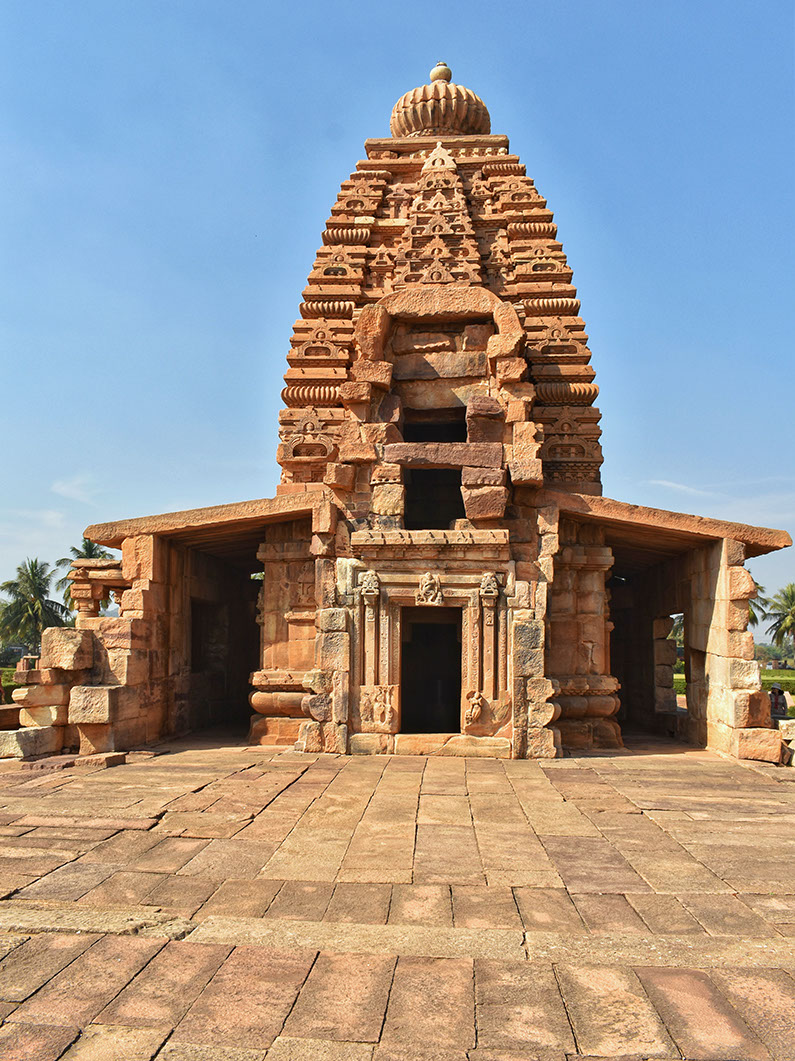
Sabhamandapa floor and Pradakshina patha of Galaganatha Temple
The Chalukyas believed in vastu shastra, so most of the Hindu temples in Pattadakal faced east and toward the river. Devotees visit the temples by bathing or washing their feet in the river. Through the Mahadwara (entry gates), they will enter the temple and proceed to Nandimandapa (the platform where Nandi is located). Then comes Mukhamandapa and Sabhamandapa, from where the actual temple begins. Sabhamadapa and Antarala lead to Garbhagriha. Temple priests live in antaralas, as is typical in North Indian temples. Same vastu principles were used to build Galaganatha temple. Sadly, only Antarala and Garbhagriha have survived, and everything else has been destroyed. However, the Pradakshina passage (circumambulatory path) between Sabhamandapa and Garbhagriha has survived. Using this path, devotees can circle around Garbhagriha. The majority of Chalukya temples were built with sandstone. These stones were carved after the temple structure was completed. The Galaganatha temple is no different.

Southern wall with an 8-armed Shiva killing demon Andhaka while wearing the skull yajnopavitha
A striking feature of this temple is its "Kirtimukh". Structures like these were placed throughout the temple to prevent evil eyes from entering. Many places still follow this ancient hindu tradition. Only one of these structures remains, on the wall of Antarala.

The only surviving "Kirtimukh" inside Galganatha temple
Chandrashekhara Temple
Located next to Galaganatha temple is Chandrashekhara temple, which is the smallest of all. It's either from the 9th or 10th century. A garbhagriha and a linga are located in a closed hall. The doorframe is carved with a few shakhas and features dwarapalakas on either side.

Located adjacent to Galaganatha Temple is the small Chandrashekhara temple
Sangameshwara Temple: A journey through Chalukyan architecture in Pattadakal
We were done with Nagara (North Indian) style Chalukya architecture in Pattadakal temple sanctuary. Next was Sangameshwara temple (also called Vijayeswara temple), which is quite large and was constructed between 720 and 733 CE in Pattadakal in the Dravidian style architecture. This beautiful temple was started by Vijayaditya (696 - 734 CE) but remains partially incomplete due to his death in 734. Its fragmented state evokes intrigue and adds a certain aura to its beauty. We loved its layers, its unique structure and design. Currently, the temple consists of Sabhamandapa, Antarala, and Garbhagriha. There are many broken sculptures, including the Lingam and Nandi.
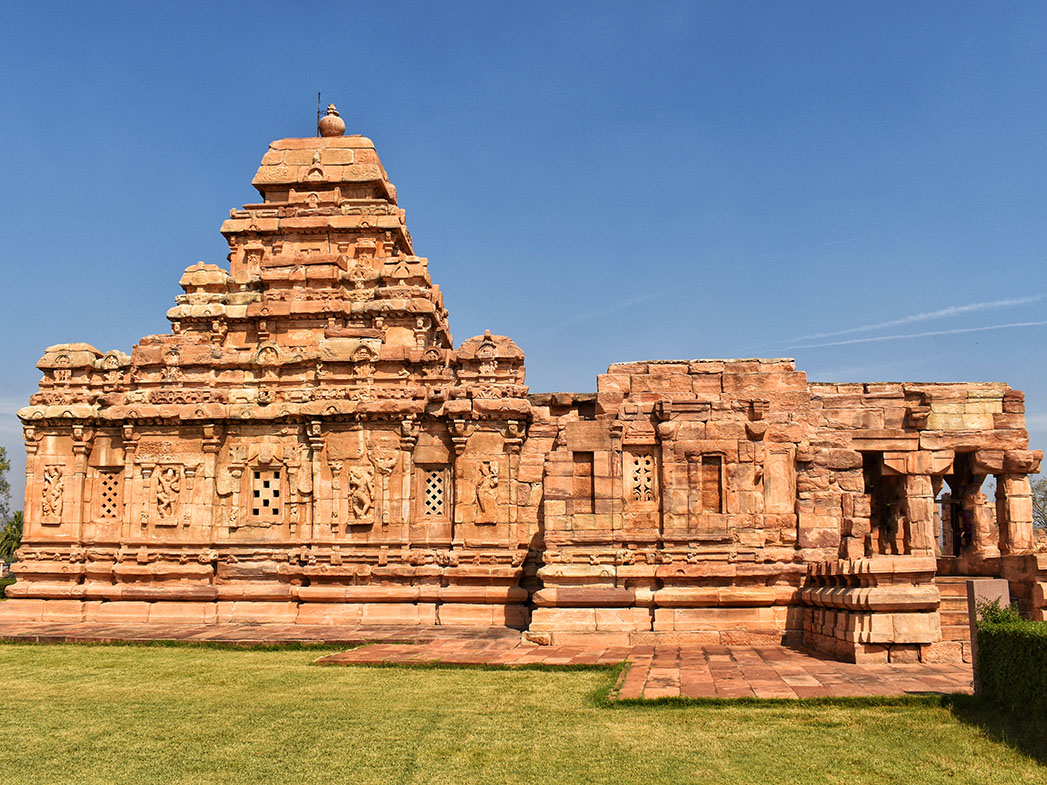
Side view of Sangameshwara temple
Due to the unfinished nature of this temple, you can see line markings on the stones. These markings were made to indicate the design of the structure to be carved there. It portrays the process they followed in designing the interiors of the temples. According to Mrityunjaya, this temple is the only place where you can find such drawings.

This sketch illustrates the design that will be carved on the temple's interior walls
Even during the Chalukya era, donations were collected to build temples. There is an inscription on one of the pillars of Sangameshwara temple in 7th century Kannada, which is quite different from today's Kannada script. It was Mrityunjaya who skillfully read the script to us and explained its significance. This script reads, "Swasti stree vijayeshvara natya chalabbe khambha muru." It means a lady dancer named Chalabbe donated money to build three pillars for the temple.

Kannada inscriptions on the pillar from the 7th century indicate donations were collected for the temple
There are many holes in the floors of temples that are usually used for grinding spices and chutneys. This suggests that after the temples were abandoned, people lived inside them.
Once you step out of Sangameshwara temple and turn right, you will see a big Vijayastambh. The pillar was erected as a victory symbol after Vikramaditya II (733 - 744 CE) defeated the Pallavas in three wars between 740 and 744 CE. There are inscriptions on this pillar in two languages, Devanagari and Kannada. The two queens he had were Lokamahadevi and Trilokamahadevi. To commemorate their victories, both queens built separate temples, Virupaksha and Mallikarjuna.

Vijayastambh of Pattadakal - the celebration of Vikramaditya II's victory over the Pallavas
The Grandeur of Virupaksha Temple
In 740 CE, Queen Lokamahadevi built the lavishly sculpted Virupaksha temple in Pattadakal, hence the temple is also known as Lokeshvara. Since this is the only live Hindu temple in the Pattadakal heritage complex, you must remove your footwear before entering.

The north-east view of Virupaksha temple in Pattadakal
It is one of the very few Chalukya temples where the architects' identities are revealed. The ambitious project was the brainchild of two master architects, Gunda-Anivaritachari and Sarvasiddhi-Achari. For their notable contributions, King Vikramaditya II conferred the state honor (perijereppu patta) on them both. The temple also commemorates the artists who carved the beautiful sculptures and carvings in Pattadakal by inscribing their names beneath each panel.

7th century Kannada inscriptions mentioning the names of temple architects
As this temple has lavish carvings both on the outside and inside, Mrityunjaya began our tour with the outside walls. The first notable carving is of "Gandabherunda." This is the state emblem of Karnataka and the rajamudra of Wadiyars (Mysore kingdom). It represents the mythological character Gajakesari (a hybrid of an elephant and a lion).

Gandabherunda - the state emblem of Karnataka
You will feel as if you are standing in front of a mythological enigma when you see the exterior walls. The knowledge of Mrityunjaya, however, made it easy for us to understand each carving. The temple walls have 18 windows. The artists also ensured that all designs in the windows were unique and not repeated elsewhere. It emphasizes all the minor aspects of Indian mythology, such as the Peacock, Asopalav, and crocodile.

Shiva in Nataraja form, the intricate design of Peacocks and carvings of Shiva, Parvati and Nandi on the outer walls of Virupaksha temple
On the opposite outer wall, Mrityunjaya pointed out a specific sculpture and asked if we recognized it. While he was certain we knew about this mythological figure, we still couldn't figure it out. It was "Harihara" in a sitting position. Most of the time, you see them standing, but this design is quite rare.

Harihara in sitting posture (top) and a discussion between two saints (bottom)
It was time to remove our shoes and climb the stairs to Sabhamandapa. As Mrityunjaya explained, everything in the temple is in accordance with Vastushastra. Then he pointed to the ceiling. We were awestruck by the design of Lord Surya riding on his chariot with seven horses. Suryadev is shown holding two lotus flowers while his charioteer Aruna (brother of Garuda) rides his chariot. Suryadev is guarded by Usha and Chhaya.

The sculpture of Lord Surya on his chariot on the ceiling at the entrance to the temple
Sabhamandapa is guarded by the Dwarapalakas (door keepers) of Shiva, Bhadra, and Virbhadra. In the side wall are two more Dwarapalakas of Kuber, Shankhanidhi and Padmanidhi. Each side of the doorframe has three shakhas.

Entrance of Virupaksha temple
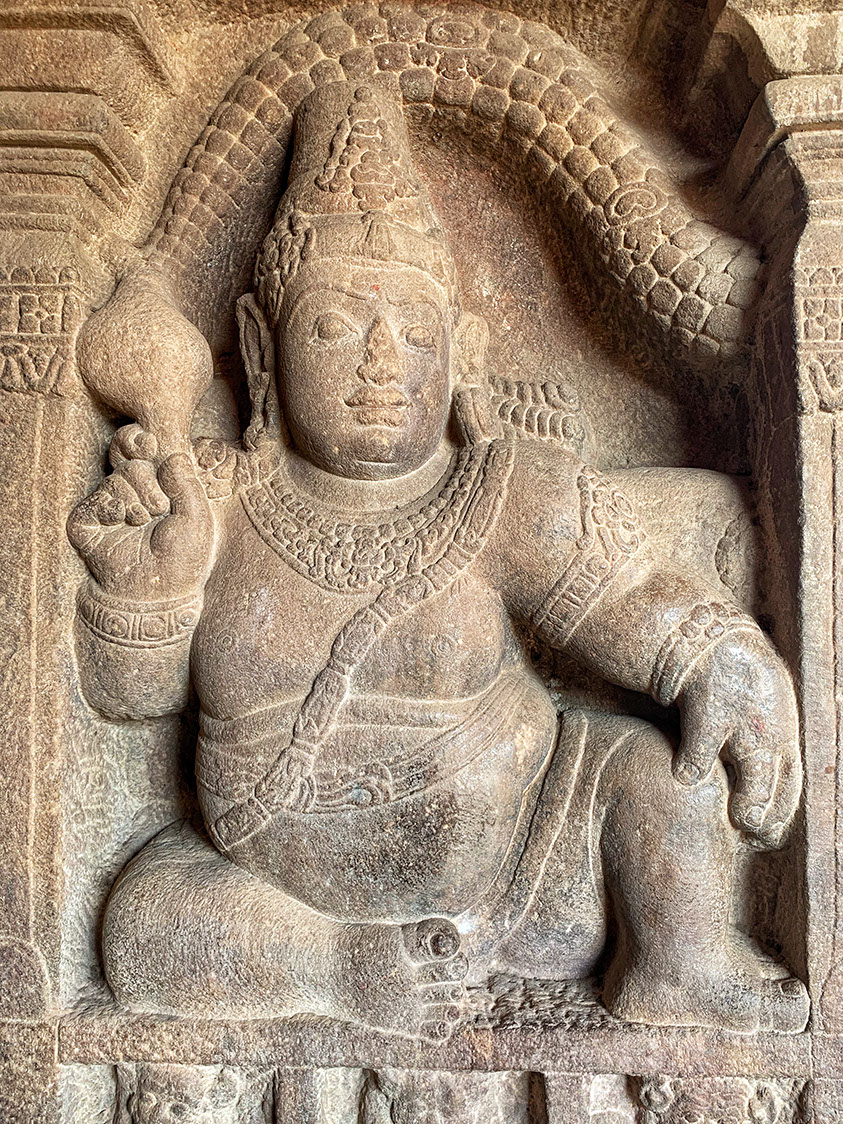
Beautiful sculpture of Shankhanidhi, the dwarapalaka of Kuber
There are 18 pillars supporting the entire Sabhamandapa. Many of the pillars have friezes with Hindu mythological stories from the Ramayana, Mahabharata, and Panchatantra.

A chapter from Ramayana where monkeys build Rama Setu and Hanuman arrives in Lanka and causes mayhem with his burning tail

One of the pillars of Chalukya culture depicts fashion, dressing, and makeup among ladies even before 1,400 years
Inside Antarala, just before the Garbhagriha, is a beautiful stone carving of Mahishasuramardini (an incarnation of Parvati) killing the buffalo.

Beautifully sculpted statue of Mahishasuramardini inside Virupaksha temple
An enormous monolithic Nandi statue is placed in the Nandimandapa on the north side of the temple. A portion of the statue was damaged, but archaeologists recently resurrected it. A priest is present at the temple, so people can offer puja here.

Resurrected 1,400-year-old statue of Nandi
It is believed that Kailasha temple at Ellora caves was modeled after Virupaksha temple of Pattadakal. The Virupaksha temple itself, however, was modeled after the Kailasanatha temple of Kachipuram (the Pallava capital).

The south view of Virupaksha temple
Mallikarjuna Temple
Mallikarjuna temple in Pattadakal, also known as Trilokeshwara temple, is similar to Virupaksha temple, but with some noteworthy differences. This is not a live temple. The younger queen, Trilokamahadevi, built this temple almost at the same time as the Virupaksha temple. She was the younger sister of Lokamahadevi.

The front view of Mallikarjuna temple with partly broken Nandimadapa
Smaller than Virupaksha temple, this temple uses stone carvings to depict mythological stories from Ramayana, Mahabharata, Panchatantra, and other sources. A few friezes depict erotic scenes from Kama and Mithuna literature on the pillar.

A pillar depicting the Panchatantra story of a monkey, crocodile, snake and mongoose (left)
Mrityunjaya explaining the narration on a pillar's frieze (right)
Kashi Vishwanatha Temple
Kashi Vishwanatha Temple is one of Pattadakal's smallest Hindu temples. It was built in the middle of the 8th century in Nagara style. The garbhagriha of the temple is quite small compared to how big it appears from the outside. The square garbhagriha is home to a linga. The garbhagriha is accessed through a door frame adorned with shakhas and flanked by rivers, Ganga and Yamuna at the bottom. There are two dwarapalakas at the entrance of the temple, Bhadra and Virbhadra.
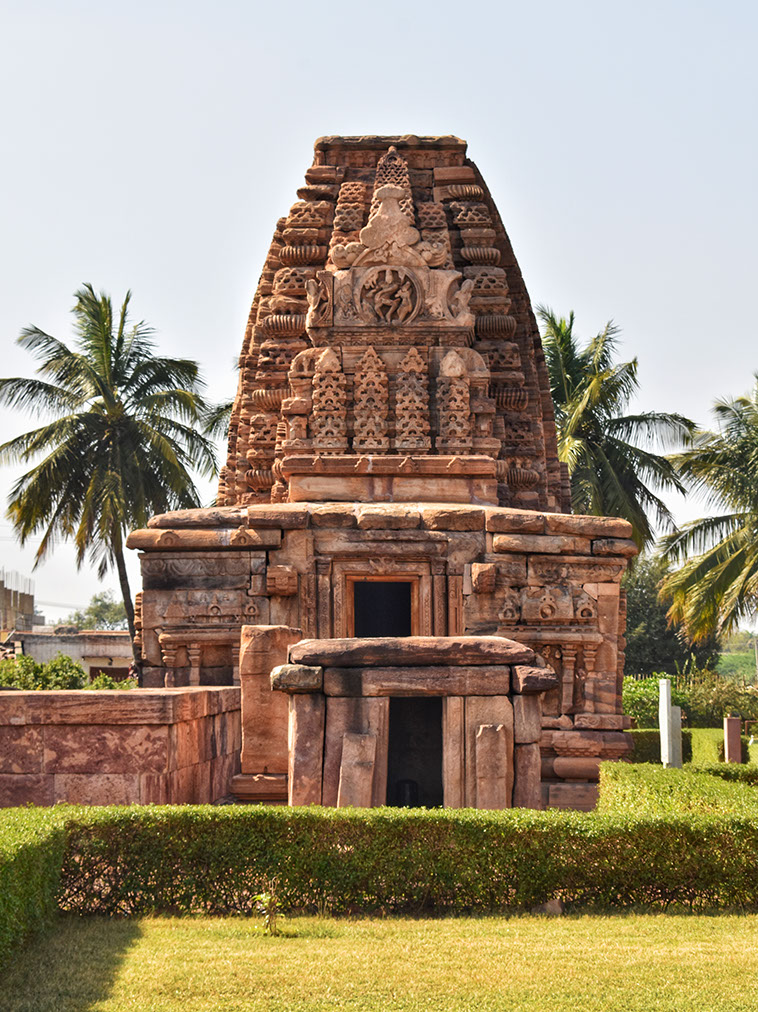
Nagara-style Kashi Vishwanatah temple with missing amalaka and kalasa
Papanatha Temple
There are eight main temples within the complex, but this is the last temple hidden away from the main cluster. Papanatha temple is just a 5-min walk from behind the Pattadakal temple sanctuary. It seems not every visitor to Pattadakal is aware of this beautiful temple since we were the only people there despite the main temple complex being packed.

Rear-view of Papanatha temple
An architectural fusion of Nagar and Dravidian styles, this temple was built by the Badami Chalukyas in the middle of the 8th century. It is one of the best temple layouts I have seen in the entire complex. Another historical marvel, we just couldn't get our eyes off the intricate carving and beautiful sculpture. Because it is such a beauty, we find it baffling that visitors don't know about this temple. It seems that construction of this temple took place in three phases, but the details do demonstrate consistency in design. This temple is quite long, with two Sabhamadapas with a smaller one (front) having four pillars and a larger one with sixteen.

Interconnected Sabhamandapas with exquisite carvings
Rather than having a Nandimadapa, there is a large Nandi placed in the smaller Sabhamandapa facing the linga. The shikhara is of nagar-style, while the temple layout, interior decorations, and plinth are Dravidian. The temple's Dravidian-style design was created by Revadi-Ovajja, a student of Sarvasiddhi-Achari, who designed Virupaksha temple. The restoration workers warned us not to visit the dark garbhagriha because a snake lives there.

The ceiling is decorated with various poses of Vishnu including reclining Anantasayana pose
That concluded our trip to Pattadakal. It was hard to believe how fast those 3-4 hours flew by. We were grateful to Mrityunjaya for his exceptional skills and service. We took a risk and it paid off. When visiting Pattadakal, I highly recommend hiring his services if you're looking for a knowledgeable and humble guide. Feel free to reach out to him on his mobile phone +91 94494 38078.

Now that the temple visits are over, it's time for a family photo
The illustration of eclectic art
"To communicate the truths of history is an act of hope for the future." - Daisaku Ikeda
The beauty we encountered during our visit is history as it is now. The magnitude of planning, the dedication and commitment to intricate detail is a wonder all by itself. We cannot imagine this kind of architecture being replicated in any of the buildings or monuments of the modern era. It is a historical treasure waiting to unfold, calling out to its people to indulge in the rich cultural heritage of the country. Pattadakal emulates the quality of art, the development of architecture and the cultural influx of Chalukya times. The temples stood proud commemorating the memories of those times, reiterating the stories of its people and the legacies they have left behind. We will always remember it as a magnificent illustration of eclectic art.
Getting There
You can reach Pattadakal via two primary routes. One route is from Bangalore (460 km) or Hubali (150 km), and the other is from Belgaum (160 km) or Goa (260 km). There are many flights and trains to Bangalore and Goa, but fewer options for Hubali. Badami has a train station, but it only connects to major cities nearby. The distance from Badami to Pattadakal is just 20 km. Buses run frequently between Badami and Pattadakal.
Hotels and Restaurants in Pattadakal
Since Pattakadal is a small village, there are no decent hotels or restaurants in the vicinity. There are a few roadside food stalls that serve quick bites, cold drinks, and ice cream. Thus, I would advise you to bring your own food. There are, however, nice hotels in Badami, which is just 30 kilometers away.
Frequently Asked Questions:
What is Pattadakal known for?
Pattadakal is an ancient temple complex and a UNESCO World Heritage Site situated in the Indian state of Karnataka. Pattadakal is renowned as one of India's finest examples of Dravidian style Chalukya architecture, with numerous Hindu temples dating back to the 7th and 8th century CE.
What are the opening hours of Pattadakal?
Temple sanctuary at Pattadakal remains open between 6 am and 6 pm all days.
What is the best time to visit Pattadakal?
Mid-afternoon or early morning are the best times to visit Pattadakal. It is best to go there after 3 pm if you are a photography enthusiast as the sun will often be on your back during that time.
What are the top attractions to see in Pattadakal?
Pattadakal, the UNESCO World Heritage Site features a unique combination of architectural styles, including Chalukya, Kadamba and Rashtrakuta, showcasing the best of Southern Indian cultural influence. A top attraction in Pattadakal is the Virupaksha Temple, a 7th century Hindu temple built during the rule of King Vikramaditya II with intricate carvings decorating its exteriors. Another unmissable site is the Mallikarjuna Temple, boasting one of the oldest architecture based on Dravidian shikhara style of temples.
How much time should I allocate to visit Pattadakal?
A half-day is ideal for exploring the Pattadakal heritage temple complex. Depending on your interest and if you want to delve deeper into the temple's history, the time might increase.
Is there a dress code to visit Pattadakal?
Except for Virupaksha temple, Pattadakal has no specific dress code. Since Virupaksha temple is a live temple, you must remove your footwear outside and cover your shoulders, chest, and knees. Wearing light clothes is recommended as Pattadakal gets quite hot in the afternoon.
Are there any local restaurants or food stalls near Pattadakal?
Pattadakal does not have any restaurants. You can get hot snacks, cool drinks, and ice-cream from street side food stalls opposite the temple complex.
Could you visit Pattadakal on a day trip from Hampi or Badami?
Since the distance between Badami and Pattadakal is just 20 km, it is quite feasible to visit Pattadakal as a day trip. A day trip to Pattadakal from Hampi is theoretically possible, but it will be too constrained. Pattadakal is about 130 km from Hampi and takes about 3 hours to travel one-way.
Can I take photographs in Pattadakal?
You are permitted to take photographs in Pattadakal temple sanctuary without paying a separate fee. Professional photography and videography with tripods are not permitted without the permission of Archaeological Survey of India (ASI).
What is the history of Pattadakal?
Badami Chalukyas developed Pattadakal mainly to perform Pattabhisheka ceremonies. In Kannada, pattabhisheka means coronation ceremony. A rock at Malaprabha river was famous for coronating Chalukya Yuvrajs (sons of Chalukya kings). A rock is called a "kal" in Kannada, hence the name Pattadakal.
Are there any guided tours available at Pattadakal?
A guided tour of Pattadakal is highly recommended. A guide can be pre-hired from references or hired on the spot at the ticket counter of the Pattadakal temple sanctuary.
Is there any accommodation available near Pattadakal?
Unfortunately, there are no decent accommodations in Pattadakal. It is recommended to book a hotel in Badami as it has several options for every budget.
Is there an entry fee for the UNESCO World Heritage Site in Pattadakal?
Visitors to Pattadakal temple sanctuary require an entry ticket of INR 40 (for Indian adults) and INR 405 (for foreigners). There is no charge for children under 15 years old.
Disclaimer: This blog may contain affiliate links. At no extra cost to you, we may get a small commission if you buy anything. All products and services we endorse have been personally used or come highly recommended to us. These incomes allow us to keep the community supported and ad-free.




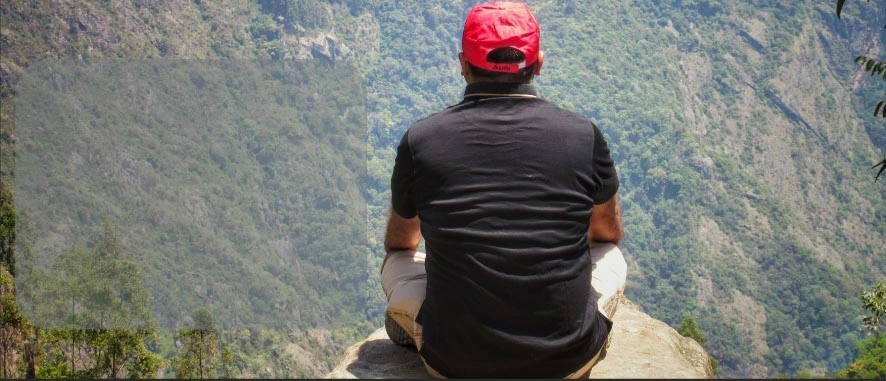

Name
Email
Comment